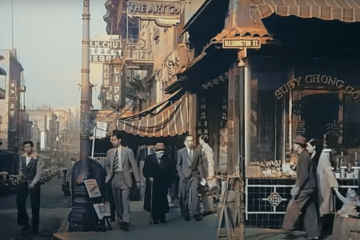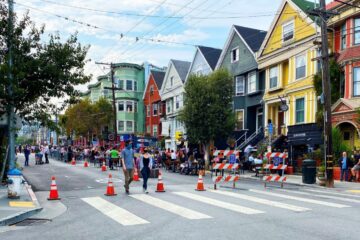The Untold Story of Filipina Women’s Contributions to SF’s Housing Rights Movement
One of San Francisco’s first major fights for housing rights took place just 40 years ago, which culminated on the night of August 4, 1977, when 3,000 activists and students from SFSU and UC Berkeley formed a chain-linked human barricade to protect the I-Hotel residents who were being evicted to make way for a parking garage.
The International Hotel, also known as the I-Hotel, was the last building on the last block of a once-thriving Manilatown that spanned from Market to Jackson along Kearny Street. It not only housed around 150 elderly Filipino and Chinese immigrants, but was also a center for Asian American activism with the nation’s oldest multidisciplinary Asian Pacific American-centered arts nonprofit Kearny Street Workshop, radical bookstore Everybody’s Books, and three Asian newspapers.
When tenants learned that the building would be demolished to become a parking garage, a multi-racial, multi-generational movement launched to preserve the housing site.
“This is the first public acknowledgement on the women who were central to the movement in the fight for the I-Hotel, and deserves significant recognition by San Francisco’s wider community.”
For the third and final installment in the San Francisco Arts Commission’s 2021 Art on Market Street Poster Series, Kimberley Acebo Arteche lifts up women’s stories in It Wasn’t Only a Hotel to pay homage to San Francisco’s Manilatown and the International Hotel.

Image courtesy of Kimberley Acebo Arteche / “It Wasn’t Only A Hotel” pays homage to the women who were central to the fight for the International Hotel, including Dr. Estella Habal, who documented the anti-eviction fight and fought for low-income housing with the reopening of the International Hotel Manilatown Center in 2005. The posters are installed in bus kiosks lining Market Street.
“The oral histories integrated into these images champion the powerful role that women played in the movement, like activist Asuncion Panlibuton, who went on to organize senior care homes and paved the way for more low-income senior housing, and Dr. Estella Habal who fought to rebuild the current I-Hotel Manilatown Center. These are the heroines of our community and help serve as keepers of our history,” Arteche said.
The fight for the I-Hotel blossomed into a broader fight for low income housing.
“We weren’t only organizing against eviction for [the] building, but also for other low income people who want to live in the city, for people who understood that housing was a human right, so it grew the movement to defend the International Hotel into a low income housing movement,” Habal shared in an interview with Arteche. “The legacy of that is still eminent today, because the issue is still current, probably even more so today.
“Today, the ten blocks of San Francisco’s Manilatown hold little visible resemblance to its history,” said Arteche.
During the 1950’s, Manilatown’s neighborhood slowly dwindled down from a 10-block stretch on Kearny Street that was home to 30,000 Filipino migrant workers, to make way for the Financial District. What remains is the International Hotel Manilatown Center, at the place where the original I-Hotel once stood.
“The oral histories integrated into these images champion the powerful role that women played in the movement, like activist Asuncion Panlibuton, who went on to organize senior care homes and paved the way for more low-income senior housing, and Dr. Estella Habal who fought to rebuild the current I-Hotel Manilatown Center. These are the heroines of our community and help serve as keepers of our history.”
Part of Arteche’s process included transcribing her interviews to include in the posters she created.
“I was an activist. I was a mother. There were a lot of women involved in the I-Hotel like me. I spent a lot of time at the I-Hotel organizing. Activism is 24 hours a day. I had children, and they went to school. Sometimes we would have meetings in the evening and that would be hard. If you had women who wanted to be involved, you had to take care of their children, too,” reads a quote from Dr. Habal, emblazoned in yellow and white text printed atop a dark blue background.
In another poster of illustrated iconography, Arteche also highlights the legacy of Manongs, elderly Filipino men who immigrated to the United States: Tino’s Barbershop, which served as a community hub for Manongs; the signature fedora hat they adopted as an expression of style; the 14:1 ratio of men to women that was intentionally enforced to keep Filipino communities from growing families.
These important sites in the local Filipinx community represent the city’s first major struggle for housing rights and the fight against displacement. The series will be up from October 14 through the end of the year in 18 MUNI bus kiosks along Market Street between Steuart and Hyde streets.
It Wasn’t Only a Hotel reimagines the notion of public monument.
“Arteche beautifully integrates oral history text and images of Manilatown to highlight the lesser-told stories of women involved in the movement to save the I-Hotel,” said Director of Cultural Affairs Ralph Remington. “These Filipino women are venerated for their activism and for being community culture bearers, paving the way that built a foundation for low-income housing in San Francisco.”
The San Francisco Arts Commission is a city agency that champions the arts as essential to daily life by investing in a vibrant arts community, commissioning public art works, and shaping cultural policy. Its other programs include: Civic Art Collection, Civic Design Review, Community Investments, Public Art, SFAC Galleries, and Art Vendor Licensing.













